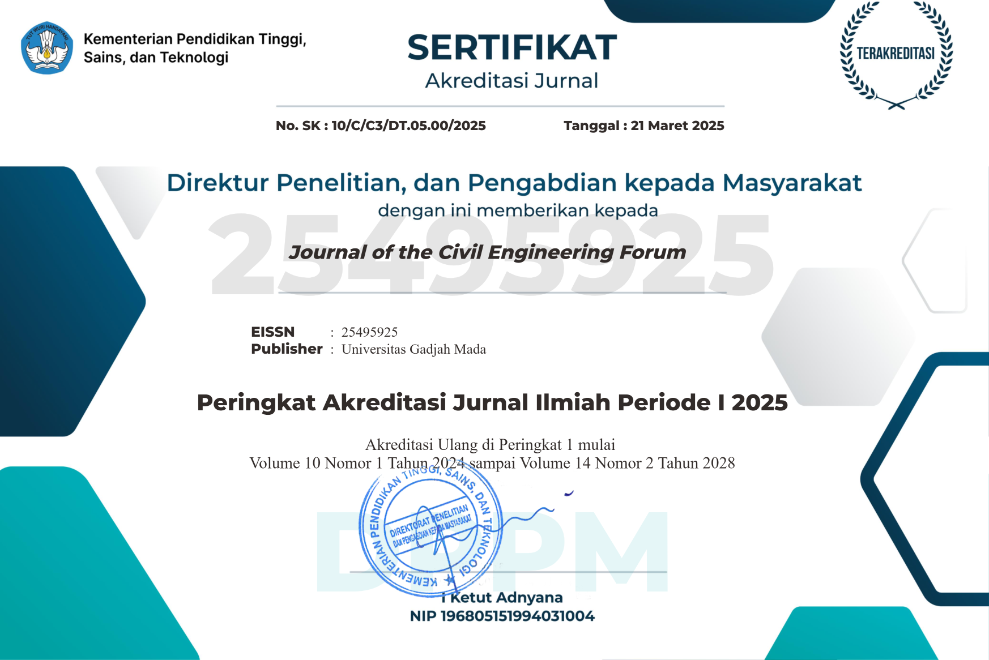Finite Element Modelling of Prestressed Concrete Piles in Soft Soils, Case Study: Northern Jakarta, Indonesia
Abstract
Jakarta is faced with limited land resources due to its position as the capital city of Indonesia. Therefore, numerous high-rise buildings are being constructed to solve this problem and provide accommodations for a large number of Jakarta residents. Studies have shown that prestressed concrete piles (spun piles) are commonly used as the foundations of high-rise buildings in metropolitan cities across Indonesia, especially in the Northern Jakarta Coastal area, which is predominant with deep soft soils deposit. To further assess and verify the ultimate capacity of the pile, a static loading test was conducted. However, not all results from the field test produced ideal, accurate, precise, and reliable load-settlement curve (until failure) results. Therefore, this study aims to determine the soil properties for the analysis of prestressed concrete spun piles with a diameter of 600 mm in the Northern Jakarta coastal area based on the standard penetration test values (SPT-N). It is a case study of a well-documented static pile load test using the kentledge system. Back analyses were performed by the finite element method to obtain the extrapolated load-settlement curve. Furthermore, the effect of interface strength between pile and soil on the load-settlement curve was also investigated. The results showed that a reduction of interface strength leads to a smaller load–settlement curve. In addition, several geotechnical engineering parameters of soil, such as the undrained shear strength and effective young's modulus, were established using data from an in-situ soil site investigation and empirical correlations with SPT-N.
References
ASTM D1586-67, 1978. Standard Method for Penetration Test and Split-Barrel Sampling of Soils. United States of America: American Society for Testing and Materials.
ASTM D1143, 2007. Standard Test Methods for Deep Foundations Under Static Axial Compressive Load. United States of America: American Society for Testing and Materials.
Bruno, D., & Randolph, M., 1999. Dynamic and Static Load Testing of Model Piles Driven into Dense Sand. Journal of Geotechnical and Geoenvironmental Engineering, 125(11), pp. 988-998.
Coduto, D.P., 2001. Foundation Design Principles and Practices 2nd ed. New Jersey: Prentice-Hall, Inc.
Crispin, J., Leahy, C., & Mylonakis, G., 2018. Winkler Model for Axially-Loaded Piles in Inhomogeneous Soil. Géotechnique Letters, 8(4), pp. 290-297.
Dandagawhal, S., 2018. Settlement Analysis of Pile Foundation using Plaxis 2D. International Journal of Science and Research, 8(9) pp. 1706–1714.
Das, B.M., 2016. Principles of Foundation Engineering. Boston: Cengage Learning.
Dias, T.G.S. & Bezuijen, A., 2018. Load-Transfer Method for Piles under Axial Loading and Unloading. J. Geotech. Geoenviron. Eng., 144(1):04017096.
Dijkstra, J., Broere, W., & Heeres, O.M., 2011. Numerical Simulation of Pile Installation. Computers and Geotechnics, 38 (5), pp. 612–622.
Gouw, T.L., 2014. Common Mistakes on the Application of Plaxis 2D in Analyzing Excavation Problems. International Journal of Applied Engineering Research, 9(21) pp. 8291–8311.
Hutabarat, L.E., Rainaldo, D., Ilyas, T., & Prakoso, W.A., 2019. Site Characterization of Marine Clay Consolidation Ratio on Kamal Muara Area, Northern Jakarta. South Lampung: International Conference on Science, Infrastructure Technology and Regional Development.
Karlsrud, K., 2014. Ultimate Shaft Friction and Load-Displacement Response of Axially Loaded Piles in Clay Based on Instrumented Pile Tests. Journal of Geotechnical and Geo-environmental Engineering, 140 (12) : 04014074.
Kitiyodom, P., Matsumoto, T., & Kanefusa, N., 2004. Influence of Reaction Piles on The Behaviour of a Test Pile in Static Load Testing. Canadian Geotechnical Journal, 41(3), pp. 408-420.
Li, J., Tan, Y. & Liang, F., 2012. A Modified Analysis Method for the Nonlinear Load Transfer Behaviour of Axially Loaded Piles. KSCE J. Civ. Eng, 16 (3), 325–333.
Lu, X., Li, P., Chen, B., & Chen, Y., 2005. Computer Simulation of The Dynamic Layered Soil–Pile–Structure Interaction System. Canadian Geotechnical Journal, 42(3), pp. 742-751.
Mahmoud, H.N., Tetsuo, T., Susumu, I., & Mourad, K., 2014. On the Influence of Vertical Loads on the Lateral Response of Pile Foundation. Computers and Geotechnics, 55, pp. 392–403.
Nasrollahzadeh, E. & Hataf, N., 2019. Experimental and Numerical Study on The Bearing Capacity of Single and Groups of Tapered and Cylindrical Piles in Sand. International Journal of Geotechnical Engineering. pp. 1-12.
PLAXIS. 2019. Manual Tutorial Plaxis 2D 2019. Netherlands: Delft University of Technology & PLAXIS.
Randolph, M.F., 2003. Science and Empiricism in Pile Foundation Design. Geotechnique, 53(10), pp. 847–875.
Rojas, E., Valle, C., & Romo, M. P., 1999. Soil-pile Interface Model for Axially Loaded Single Piles. Soils and Foundations, 39(4), pp. 35-45.
Said, I., Gennaro, V.D., & Frank, R., 2009. Axisymmetric Finite Element Analysis of Pile Loading Tests. Computers and Geotechnics, 36 (1-2), pp. 6–19.
Taqwa, F.M.L, Hutabarat, L.E., Ilyas, T., & Prakoso, W.A., 2019. Estimation of Settlement Induced Land Subsidence of Marine Clay on Kamal Muara Area, Northern Jakarta, Based on the Change of Pore Water Pressure. Lampung: 2018 International Conference on Engineering, Technologies, and Applied Sciences.
Tomlinson, M., 1994. Pile Design and Construction Practice. Fourth Edition. London: E & F N Spon.
Zhou, J.J., Wang, K.H., Gong, X.N., & Zhang, R.H., 2013. Bearing Capacity and Load Transfer Mechanism of a Static Drill Rooted Nodular Pile in Soft Soil Areas. Journal of Zhejiang University-Science A., 14, pp. 705–719.
Copyright (c) 2021 The Author(s)

This work is licensed under a Creative Commons Attribution-ShareAlike 4.0 International License.
Copyright is granted to authors for the purpose of providing protection for articles written to describe experiments and their results. JCEF will protect and defend the work and reputation of the author and are also willing to address any allegations of violation, plagiarism, fraud, etc. against articles written and published by JCEF. JCEF is published under the terms of the Creative Commons Attribution-ShareAlike 4.0 International License (CC BY-SA 4.0). The author holds the copyright and assigns the journal rights to the first publication (online and print) of the work simultaneously.







